Semi-Full Auto
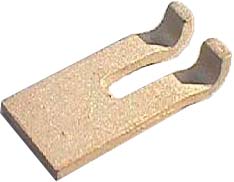 This is the link for the AK-47, and AKS series of rifles. The curved ends
catch notches at the end of the AK hammer, and hold it back until the link
is tripped by the forward movement of the bolt. It is shown approximately
twice actual size, and may be easily inserted, and removed from the weapon.
The picture was taken from an add on an Internet web sight where it was being
sold; don't ask me for the address. As there is no serial number on the piece,
and the seller in question is not a class 3 dealer, I can only assume that
the device in question is illegal, and being sold illegally. As may be seen,
this is simply a flat piece of spring steel which has been cut and bent to
size. It can be produced easily with minimal equipment for a couple of dollars,
and yet I see these bits of prison bait selling for hundreds of dollars.
This is the link for the AK-47, and AKS series of rifles. The curved ends
catch notches at the end of the AK hammer, and hold it back until the link
is tripped by the forward movement of the bolt. It is shown approximately
twice actual size, and may be easily inserted, and removed from the weapon.
The picture was taken from an add on an Internet web sight where it was being
sold; don't ask me for the address. As there is no serial number on the piece,
and the seller in question is not a class 3 dealer, I can only assume that
the device in question is illegal, and being sold illegally. As may be seen,
this is simply a flat piece of spring steel which has been cut and bent to
size. It can be produced easily with minimal equipment for a couple of dollars,
and yet I see these bits of prison bait selling for hundreds of dollars.
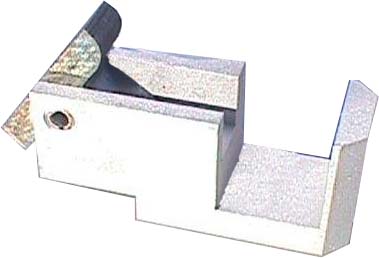 This is an example of the so called "Drop in Auto Sear" for the AR-15 rifle,
as in the case of the preceding example, this is shown approximately twice
it's actual size. This device is a bit more difficult to fabricate than the
above device for the AK. The drop in sear actually requires some machining
and milling be done; it is also composed of two parts, one of which is a
moving part. These too are selling for much more than their complexity, quality,
and cost of manufacture would mandate. In all of these cases the cost is
a reflection of the non-compliant, black market nature of these devices. I
want to emphasize that it is not illegal to own these devices, but legal ownership
is highly regulated, and expensive. Like the above device, this requires
no modification to the firearm. The upper receiver of the AR-15 is tipped
up, and this device is placed at the rear of the action with the toggle placed
towards the front. The pin holding the rear of the upper receiver also holds
the drop in sear in place. After installation, the toggle performs the function
of the auto sear, by being forced down when the bolt returns to battery.
when the toggle is forced down, it presses upon the disconnector, causing
it to release the hammer. As long as the trigger is held back the rifle will
continue to fire. This device has no effect on the primary sear, so the rifle
will stop firing when the trigger is released.
This is an example of the so called "Drop in Auto Sear" for the AR-15 rifle,
as in the case of the preceding example, this is shown approximately twice
it's actual size. This device is a bit more difficult to fabricate than the
above device for the AK. The drop in sear actually requires some machining
and milling be done; it is also composed of two parts, one of which is a
moving part. These too are selling for much more than their complexity, quality,
and cost of manufacture would mandate. In all of these cases the cost is
a reflection of the non-compliant, black market nature of these devices. I
want to emphasize that it is not illegal to own these devices, but legal ownership
is highly regulated, and expensive. Like the above device, this requires
no modification to the firearm. The upper receiver of the AR-15 is tipped
up, and this device is placed at the rear of the action with the toggle placed
towards the front. The pin holding the rear of the upper receiver also holds
the drop in sear in place. After installation, the toggle performs the function
of the auto sear, by being forced down when the bolt returns to battery.
when the toggle is forced down, it presses upon the disconnector, causing
it to release the hammer. As long as the trigger is held back the rifle will
continue to fire. This device has no effect on the primary sear, so the rifle
will stop firing when the trigger is released.
 This is a "lightning Link" the cheapest and most infamous of all of the auto
sear devices, being cut or stamped out of a flat piece of sheet metal. The
lightning link has earned itself quite a reputation in certain circles, and
caused quite a stir when it was first concocted. This is the "Saturday Night
Special" of the full auto world, and as such, is the horror of the anti gun
left. The Lightning Link functions in a similar manner to the drop in sear
listed above, but depends upon the tension and rigidity of the spring steel
used in it's construction to hold it in place, rather than being held rigidly
in place by a block of steel. It is installed by clipping the two pieces together
into a sort of an L shape. The longer of the two pieces goes around the trigger
group, while the shorter piece sticks up behind the rear pin holding the
upper and lower receivers together. As can be seen in the photo, the lightning
link goes over the disconnector, and is held in place be a tension between
the disconnector and the rear pin holding the receivers together. When the
bolt
This is a "lightning Link" the cheapest and most infamous of all of the auto
sear devices, being cut or stamped out of a flat piece of sheet metal. The
lightning link has earned itself quite a reputation in certain circles, and
caused quite a stir when it was first concocted. This is the "Saturday Night
Special" of the full auto world, and as such, is the horror of the anti gun
left. The Lightning Link functions in a similar manner to the drop in sear
listed above, but depends upon the tension and rigidity of the spring steel
used in it's construction to hold it in place, rather than being held rigidly
in place by a block of steel. It is installed by clipping the two pieces together
into a sort of an L shape. The longer of the two pieces goes around the trigger
group, while the shorter piece sticks up behind the rear pin holding the
upper and lower receivers together. As can be seen in the photo, the lightning
link goes over the disconnector, and is held in place be a tension between
the disconnector and the rear pin holding the receivers together. When the
bolt 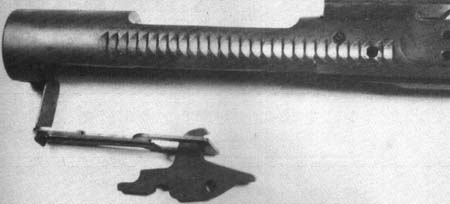 comes all the way forward, it increases the tension on the link which in
turn puts tension on the disconnector, pulling it off of the hammer sear
and releasing the hammer. The lightning link need not even be bought, as
it is so simple to make that any one with a Moto-tool, or even a pair of
tin snips could fabricate one. This is a pretty good illustration of the
main pitfall of these types of devices, and the danger they can present for
the user. This is so easily and cheaply made that it may not be taken very
seriously by the experimenter, or the curious until they find themselves staring
at a long prison term and hefty fine.
comes all the way forward, it increases the tension on the link which in
turn puts tension on the disconnector, pulling it off of the hammer sear
and releasing the hammer. The lightning link need not even be bought, as
it is so simple to make that any one with a Moto-tool, or even a pair of
tin snips could fabricate one. This is a pretty good illustration of the
main pitfall of these types of devices, and the danger they can present for
the user. This is so easily and cheaply made that it may not be taken very
seriously by the experimenter, or the curious until they find themselves staring
at a long prison term and hefty fine.
Besides the obvious legal problems, there are some other problems with the drop in sears. First, though the drop-ins mimic the action of the factory sears, these are not true auto sears, and can be some what temperamental. It must be remembered that the firearms in which these devices are used, were not originally designed to produce full auto fire in this fashion. Proper adjustment and reliability can be a matter of luck. Since many of these devices are produced in backyard, and basement shops, they are not something I would want to stake my life on, or put into a firearm which I may someday have to rely upon. The other problem with these devices is that the rifle is transformed to fire in full auto mode only. The only way to convert back to semi auto is to open the action and remove the drop in sear. In the real world, semi auto fire is far more useful than full auto in all but a few situations.
On the plus side, these devices are cheap if you make them yourself, they do work, and they leave no permanent incriminating modifications on your gun. Of course, you must decide if the potential legal problems are worth whatever advantage you think full auto capability will provide. I have some really mixed feelings about people having and using these devices. On the one hand I do not believe that the government has the right to restrict devices of this type, or machine guns, silencers, or any of the other banned weapons. These types of legislation would seem to be clearly forbidden by the Second Amendment. On the other hand, these laws have been made, and it is a not acceptable to have each individual making up his own mind about whether or not he ought to be obligated to obey this or that law based upon his own idea of the validity of the law in question. A better solution for the civilian, who is not anxious to flout the laws of the Federal government, might be one of the non NFA trigger devices.
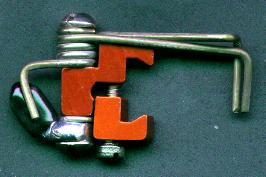 These tend to be crank, ratchet, or spring devices which work
on the trigger rather than the hammer or disconnector. Since the trigger
is pulled for each round discharged, these devices are not covered by the
NFA of 1934, and federal restrictions do not apply to them. However, many
local and state governments have seen fit to take it upon themselves to restrict
the use and ownership of these devices. Though legal in most places, most
of these rapid fire mechanisms are almost as over priced as the NFA type devices
mentioned above. The best of them seems to be the Hellfire Device or later
Hellstorm, which will work with just about any semi auto rifle. Many of the
others do not work well with certain weapons. The Hellfire device puts tension
on the trigger so that it is unstable enough to be set off by the inertia
of the gun as it is fired. Similar designs are the tac trigger systems. I
have actually seen master pistol shots do the same thing to semi auto pistols,
using the index finger of their weak hands. Unfortunately, this is not an
option for semi auto rifles. The G.A.T. is a cranking device which
is less touchy, but more cumbersome than the spring devices. If you are viewing
this page at
These tend to be crank, ratchet, or spring devices which work
on the trigger rather than the hammer or disconnector. Since the trigger
is pulled for each round discharged, these devices are not covered by the
NFA of 1934, and federal restrictions do not apply to them. However, many
local and state governments have seen fit to take it upon themselves to restrict
the use and ownership of these devices. Though legal in most places, most
of these rapid fire mechanisms are almost as over priced as the NFA type devices
mentioned above. The best of them seems to be the Hellfire Device or later
Hellstorm, which will work with just about any semi auto rifle. Many of the
others do not work well with certain weapons. The Hellfire device puts tension
on the trigger so that it is unstable enough to be set off by the inertia
of the gun as it is fired. Similar designs are the tac trigger systems. I
have actually seen master pistol shots do the same thing to semi auto pistols,
using the index finger of their weak hands. Unfortunately, this is not an
option for semi auto rifles. The G.A.T. is a cranking device which
is less touchy, but more cumbersome than the spring devices. If you are viewing
this page at  600x800, the two photos on the left are of the hellstorm. The top photo is
a close up of the device itself; the lower one shows how it is attached to
an AR-15. Lower down, and to the right is a photo of the G.A.T. cranking
device. Both of these photos were acquired at http://www.RealAmmo.com/ . I have no
misgivings about giving out this address, as both of these devices are legal
in most states, and may be purchased from the listed website. Certainly all
of these devices violate the spirit if not the letter of the NFA, but as
I consider the NFA to be an unconstitutional, and badly thought out set of
restrictions, I don't lose too much sleep over it. I have not seen the old
Tri-Burst device in ages, and must assume that the company has gone out of
business. This device was a lever attached to the trigger guard, which when
fully depressed would cycle the trigger three times in quick succession.
600x800, the two photos on the left are of the hellstorm. The top photo is
a close up of the device itself; the lower one shows how it is attached to
an AR-15. Lower down, and to the right is a photo of the G.A.T. cranking
device. Both of these photos were acquired at http://www.RealAmmo.com/ . I have no
misgivings about giving out this address, as both of these devices are legal
in most states, and may be purchased from the listed website. Certainly all
of these devices violate the spirit if not the letter of the NFA, but as
I consider the NFA to be an unconstitutional, and badly thought out set of
restrictions, I don't lose too much sleep over it. I have not seen the old
Tri-Burst device in ages, and must assume that the company has gone out of
business. This device was a lever attached to the trigger guard, which when
fully depressed would cycle the trigger three times in quick succession. One advantage that all of these trigger devices have over the drop in sears is that they allow the user to quickly switch over to single
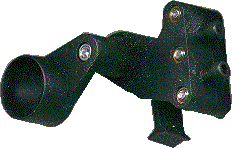 shot firing by simply bypassing them and squeezing the trigger directly.
There is also the undeniable advantage of not having to find a hiding place
for these devices, and of being able to use them without taking a chance
on going to prison. Most of them can be had for between $30-$50, which is
really quite a sum of money for a bit of wire, and plastic, but it does beat
having to mutilate your firearm, and maybe being mutilated yourself by the
legal system. Full auto fire can be a lot of fun, but it's practical uses
are so limited that it is hardly worth the effort, and certainly not worth
the risk. The civilian marksman and sport shooter will probably find his
taste for full auto shooting more than satisfied by the legal trigger devices
available.
shot firing by simply bypassing them and squeezing the trigger directly.
There is also the undeniable advantage of not having to find a hiding place
for these devices, and of being able to use them without taking a chance
on going to prison. Most of them can be had for between $30-$50, which is
really quite a sum of money for a bit of wire, and plastic, but it does beat
having to mutilate your firearm, and maybe being mutilated yourself by the
legal system. Full auto fire can be a lot of fun, but it's practical uses
are so limited that it is hardly worth the effort, and certainly not worth
the risk. The civilian marksman and sport shooter will probably find his
taste for full auto shooting more than satisfied by the legal trigger devices
available.